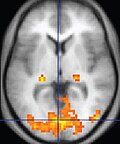Mind: Difference between revisions
CSV import Tags: mobile edit mobile web edit |
CSV import |
||
| Line 46: | Line 46: | ||
{{stub}} | {{stub}} | ||
{{dictionary-stub1}} | {{dictionary-stub1}} | ||
<gallery> | |||
File:Mental_capacities.svg|Mental capacities | |||
File:Müller-Lyer_illusion_-_simple.svg|Müller-Lyer illusion - simple | |||
File:Dualism-vs-Monism.png|Dualism vs Monism | |||
File:Gray726-Brodman-prefrontal.svg|Brodmann prefrontal | |||
File:Turing_test_diagram.png|Turing test diagram | |||
File:OCD_handwash.jpg|OCD handwash | |||
File:1206_FMRI.jpg|FMRI | |||
File:Braininvat.jpg|Brain in a vat | |||
File:Phrenology1.jpg|Phrenology | |||
</gallery> | |||
Latest revision as of 21:38, 23 February 2025
Mind
The mind is the set of cognitive faculties including consciousness, perception, thinking, judgement, and memory. It is usually defined as the faculty of an entity's thoughts and consciousness. It holds the power of imagination, recognition, and appreciation, and is responsible for processing feelings and emotions, resulting in attitudes and actions.
Overview[edit]
There is a lengthy tradition in philosophy, religion, psychology, and cognitive science about what constitutes a mind and what are its distinguishing properties. The mind is often understood as a set of cognitive faculties, separated from the physical body. Its features can be categorized into a number of basic capacities, which include perception, memory, imagination, and volition.
Philosophical perspectives[edit]
The philosophy of the mind studies such issues as the problem of understanding consciousness and the mind–body problem. The nature of the mind has been a topic of discussion in philosophy since antiquity; it remains a widely debated subject in philosophy of mind.
Psychological perspectives[edit]
Psychology is the scientific study of the mind and behavior. Psychologists study the mind's phenomena and processes, with a focus on understanding consciousness, cognition, and the nature of the mental functions.
Neuroscientific perspectives[edit]
Neuroscience studies the neural underpinnings of mental functions and consciousness, using a variety of experimental techniques, such as neuroimaging and computational modeling.
See also[edit]
References[edit]
<references />
External links[edit]
| Consciousness | ||||||||||||||||||||||||
|---|---|---|---|---|---|---|---|---|---|---|---|---|---|---|---|---|---|---|---|---|---|---|---|---|
|
| Cognitive science | ||||||||
|---|---|---|---|---|---|---|---|---|
This Cognitive science related article is a stub.
|
| Psychology | ||||||||||
|---|---|---|---|---|---|---|---|---|---|---|
|
| Neuroscience | ||||||||||
|---|---|---|---|---|---|---|---|---|---|---|
|












